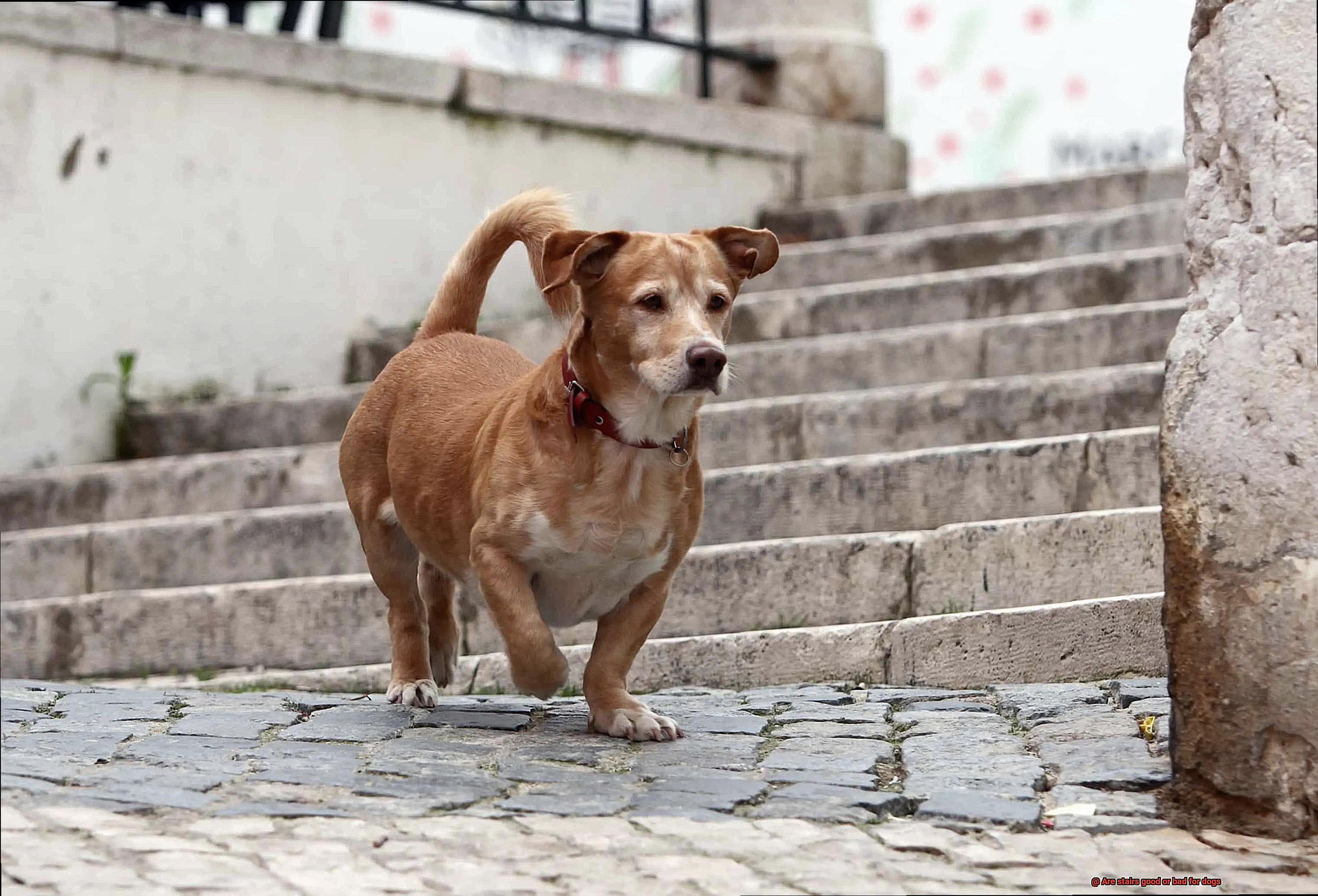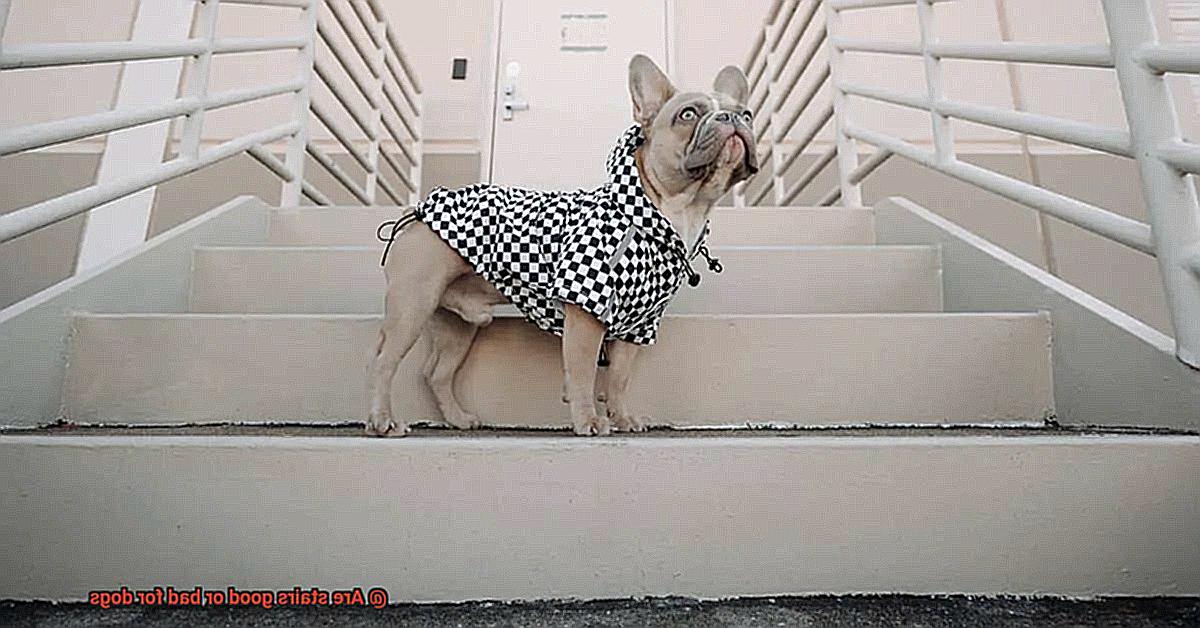Are stairs good or bad for dogs?
When it comes to our furry pals, we’ve got their backs. From scrumptious meals to playtime galore, we strive to create a doggy paradise. But there’s one thing that leaves us scratching our heads: are stairs a friend or foe for our four-legged buddies?
Some pet parents see stairs as harmless hurdles, while others fret about potential perils. In this blog post, we’ll unravel the mysteries of the stair dilemma, considering not only physical and mental effects but also safety concerns.
Let’s start with the upsides of stairs for our canine companions. First off, they can be a paw-some way to keep those pounds in check and muscles in tip-top shape. Climbing stairs gives dogs a cardio boost and builds strength. This is especially great for older pups or those with limited mobility since stairs offer a low-impact workout option.
But it doesn’t stop there. Stairs tickle your dog’s brain cells too. As they strut their stuff up and down those steps, their minds get a workout too. Problem-solving skills get sharper and spatial awareness gets an upgrade.
However, let’s not forget the potential downsides. For dogs with conditions like arthritis or hip dysplasia, stairs can be a real pain in the tail – literally. They could worsen discomfort and lead to more joint damage. In such cases, limiting stair time or considering mobility aids might be wise.
Safety first is our mantra. Dogs with long legs or little agility might find themselves slipping and sliding on stairs. And if those steps are steep or slippery? Yikes. It’s crucial to have well-maintained staircases that provide secure footing for your furry friend.
So here’s the scoop: whether stairs are good or bad for dogs isn’t set in stone. It depends on factors like age, health, and safety precautions. As responsible pet parents, our mission is to ensure our pooches’ well-being by understanding their unique needs and taking necessary steps (pun intended.) to make stair time safe and fun. Stay tuned as we dive deeper into this topic and dish out tips for optimizing stairs for our canine companions in future blog posts.
Understanding the Impact of Stairs on Dogs
Contents
- 1 Understanding the Impact of Stairs on Dogs
- 2 Factors to Consider When Assessing Stair Use for Dogs
- 3 Benefits of Stairs for Young and Healthy Dogs
- 4 Risks of Stairs for Older or Health-Compromised Dogs
- 5 Breeds Prone to Joint Issues and Potential Complications with Stairs
- 6 Signs a Dog Is Struggling with Stairs
- 7 Making Stairs More Dog-Friendly
- 8 Consulting With a Veterinarian About Your Dog’s Ability to Use Stairs
- 9 Conclusion
As a French Bulldog owner, you may wonder about the impact of stairs on your beloved pet. Stairs can be a common feature in many homes, but they can pose risks and challenges for dogs, especially those with certain health conditions or physical limitations. In this informative blog post, we will explore the impact of stairs on dogs, particularly French Bulldogs, and provide insights and tips to ensure their safety and comfort.
- Joint Health: One of the main concerns when it comes to dogs and stairs is the impact on their joint health. French Bulldogs are prone to joint issues, such as hip dysplasia. Climbing up and down stairs can put strain and stress on their joints, potentially worsening their condition. It is crucial to be mindful of this and take necessary precautions to protect their joints.
- Risk of Injury: Stairs also pose a risk of injury for French Bulldogs. Their short legs and compact bodies make them more susceptible to accidents and falls. Slippery surfaces, steep inclines or declines, and inadequate lighting can increase the likelihood of accidents. To mitigate these risks, consider installing carpet or grip strips on the steps for better traction and ensure proper lighting.
- Behavioral Impact: Some French Bulldogs may develop anxiety or fear related to stairs due to past negative experiences or lack of exposure. This can lead to avoidance behavior or reluctance to use stairs altogether. It is important to address these behavioral aspects with patient training and positive reinforcement techniques to help your furry friend feel more comfortable and confident when using stairs.
- Age Considerations: Age plays a significant role in assessing the impact of stairs on French Bulldogs. Puppies have developing bodies, and their joints are not fully formed yet. It is important not to allow them to navigate stairs until they have matured physically. Older French Bulldogs may also have reduced mobility or joint issues, requiring extra care and supervision when using stairs.
Safety Measures for Your French Bulldog:
- Install carpet or grip strips on the steps for better traction.
- Ensure proper lighting to prevent accidents.
- Use baby gates or barriers to restrict access to stairs if necessary.
- Consider providing alternative options, such as a ramp, for dogs with mobility issues.
- Consult with your veterinarian for personalized advice based on your French Bulldog’s specific needs and health condition.
Factors to Consider When Assessing Stair Use for Dogs
As an expert in assessing stair use for dogs, there are several factors that should be taken into consideration when allowing a French Bulldog to use stairs. These factors include the dog’s physical health, age and size, training and familiarity with stairs, stair design and safety measures, and the frequency of stair use.
- Dogs’ physical health: Dogs with certain health conditions, such as arthritis or hip dysplasia, may find it difficult or painful to navigate stairs. It is important to consider their physical health and consult with a veterinarian if necessary before allowing them to use stairs. The impact of climbing up and down stairs can put strain on their joints and exacerbate their existing conditions.
- Age and size of the dog: Puppies and older dogs tend to have less strength and stability, making it more challenging for them to climb stairs safely. Additionally, small breed dogs, like French Bulldogs, may struggle with stairs due to their limited agility and reach. Assessing whether the dog’s age and size are compatible with using stairs is crucial for their safety.
- Training and familiarity: A dog’s training and familiarity with stairs play a significant role in determining whether stairs are suitable for them. Dogs that have been properly trained to navigate stairs from a young age are generally more comfortable and confident in using them. However, dogs that have never encountered stairs or have had negative experiences may develop fear or anxiety around staircases. Gradual introduction to stairs through positive reinforcement-based training methods can help overcome these issues.
- Stair design and safety measures: The design of the stairs themselves should be considered as well. Factors such as the height, width, and depth of the steps can affect a dog’s ability to use them comfortably. Steep or narrow steps can pose a challenge for dogs, especially those with shorter legs or mobility issues. Additionally, the presence of handrails or non-slip surfaces can provide added support and stability for dogs using stairs.
- Frequency of stair use: The frequency at which a dog needs to use stairs should also be taken into account. If a dog needs to navigate stairs multiple times a day, it is essential to ensure that they can do so safely and comfortably. On the other hand, if stairs are only encountered occasionally or can be avoided altogether, the impact on a dog’s overall well-being may be minimal.

Benefits of Stairs for Young and Healthy Dogs
If you’ve got a young and healthy pup at home, you may be wondering whether stairs are a good idea for them. Well, let me tell you, stairs can be a total game-changer for your furry friend. Here are some tail-wagging benefits that will have you saying “oui oui” to stairs:
- Physical Exercise: We all know how important exercise is for our four-legged friends, and stairs provide a fantastic opportunity for them to get moving. By trotting up and down those steps, your French Bulldog can strengthen their leg muscles, improve their heart health, and keep those pesky extra pounds at bay.
- Mental Stimulation: Climbing stairs isn’t just a physical challenge; it’s also a mental workout. Your clever Frenchie will need to use their problem-solving skills and coordination to conquer those steps successfully. This mental stimulation is especially beneficial for active breeds like French Bulldogs who thrive on challenges and need outlets for their energy.
- Joint Health: Good joint health is crucial for our furry friends, and climbing stairs can help keep those joints in tip-top shape. The repetitive motion of going up and down the stairs helps strengthen the muscles surrounding the joints and increases their flexibility. It’s like doing yoga for dogs.
- Confidence Boost: Conquering those stairs can give your Frenchie a major confidence boost. Young pups or previously hesitant climbers will feel like champions as they navigate each step with ease. Watch out world, here comes a confident Frenchie.
- Bonding Time: Who doesn’t love spending quality time with their furry best friend? Using stairs together is not only a great way to bond but also provides an opportunity for some exercise for both of you. Your Frenchie will enjoy the attention and companionship as you climb those stairs side by side.
- Energy Release: If you’ve got a young Frenchie with boundless energy, stairs can be a lifesaver. Instead of letting them bounce off the walls, let them burn off that excess energy on the stairs. It’s like having their very own doggy gym.
- Agility Training: Is your Frenchie a natural-born athlete? Well, stairs can be a fantastic addition to their agility training routine. They provide a natural obstacle that can help them develop their coordination, balance, and agility skills. Who knows, maybe your Frenchie is destined for the Olympics of the dog world.
Remember, while stairs can be pawsitively amazing for young and healthy French Bulldogs, it’s essential to make sure they are safe and suitable for your pooch. If your Frenchie has any pre-existing health conditions or joint problems, it’s always best to consult with your vet before encouraging them to use stairs regularly.
Risks of Stairs for Older or Health-Compromised Dogs
As dogs age or face health issues, stairs can pose significant risks to their well-being. Let’s explore some of the reasons why stairs can be problematic for older or health-compromised dogs.
- Decreased Mobility and Joint Pain: Just like humans, dogs can experience decreased mobility and joint pain as they age. This can make navigating stairs a daunting task. They may struggle to climb up or down the stairs, increasing the risk of falls and injuries.
- Arthritis: Arthritis is a common condition in older dogs, causing stiffness and pain in their joints. Climbing stairs can exacerbate these symptoms and put additional strain on already weakened joints.
- Hip Dysplasia: Dogs with hip dysplasia, a genetic condition that affects the hip joints, may find it painful and challenging to use stairs. The repetitive motion of climbing stairs can worsen their condition and lead to further discomfort.
- Recovery from Surgeries or Injuries: Dogs recovering from surgeries or injuries may have limited mobility and healing wounds, making navigating stairs unsafe and hindering their recovery process.
- Vision Problems: Vision problems such as cataracts or glaucoma can affect a dog’s depth perception and spatial awareness. This can make stairs seem more daunting and increase the likelihood of accidents.
- Spinal Issues: Certain breeds are more prone to spinal issues such as intervertebral disc disease (IVDD). For these dogs, using stairs regularly can put stress on their spine and increase the risk of spinal cord injury.
- Heart Conditions and Respiratory Problems: Dogs with heart conditions or respiratory problems may experience breathing difficulties when climbing stairs due to the increased effort required. This can lead to exhaustion and potential health complications.
It’s important to consider the size and structure of the staircase itself when assessing the risks for older or health-compromised dogs. Steep or narrow staircases can be particularly challenging for dogs with mobility issues, as they require more strength and balance to navigate safely.
By understanding these risks, dog owners can take appropriate measures to ensure their pets’ safety and well-being. These may include installing ramps, using baby gates to restrict access to staircases, or providing alternative sleeping areas on the ground floor. Consulting with a veterinarian can provide further guidance tailored to your dog’s specific needs.
Breeds Prone to Joint Issues and Potential Complications with Stairs
Why Climbing Stairs Can Be a Challenge for French Bulldogs
French Bulldogs, with their adorable squishy faces and compact bodies, are a popular breed among dog lovers. However, their unique physique can make climbing stairs a real struggle for them, especially as they age. Let’s take a closer look at why French Bulldogs are more prone to joint issues and potential complications with stairs.
- Short legs and stocky bodies: French Bulldogs have short legs and a stocky build, which puts added stress on their joints. This can lead to conditions like hip dysplasia and intervertebral disc disease, making it difficult for them to navigate stairs comfortably.
- Hip dysplasia: This is a common condition in French Bulldogs where the hip joint does not develop properly. It can cause pain, lameness, and difficulty in climbing stairs. According to a study published in the journal Canine Genetics and Epidemiology, French Bulldogs have a higher prevalence of hip dysplasia compared to other breeds.
- Arthritis: As French Bulldogs age, they are more susceptible to developing arthritis, which is inflammation of the joints. Arthritis can cause pain and stiffness, making it challenging for them to climb stairs without discomfort.
- Luxating patella: Another condition that French Bulldogs may experience is luxating patella, where the kneecap dislocates from its normal position. This can cause limping and difficulty in using the affected leg, making stairs a daunting task.
While these challenges may seem overwhelming, there are steps you can take to make climbing stairs easier for your French Bulldog:
- Provide alternative access: Consider installing ramps or providing alternative routes for your Frenchie to access different levels of your house. This can reduce the strain on their joints and make it easier for them to move around.
- Carpeted or non-slip surfaces: Make sure that your stairs are carpeted or have non-slip surfaces to prevent slips and falls. This is especially important for French Bulldogs with joint issues, as falls can exacerbate their existing problems.
- Weight management: Keeping your French Bulldog at a healthy weight is crucial for their joint health. Excess weight puts additional stress on their joints, making it harder for them to climb stairs. Consult with your veterinarian to determine the best diet and exercise plan for your Frenchie.
Signs a Dog Is Struggling with Stairs
Today, we’re going to talk about a topic that hits close to home for our little four-legged friends – stairs. Our beloved Frenchies may face some unique challenges when it comes to navigating those vertical obstacles. In this pawsome blog post, we’ll explore the signs that indicate your Frenchie is struggling with stairs and share some tips to make their journey easier. Let’s dive right in.
Signs Your Frenchie Needs a Stair Intervention:
Hesitation at the Staircase:
If you notice your Frenchie standing at the foot of the stairs, contemplating their ascent or descent like a canine philosopher, they may be telling you that they’re unsure about tackling those steps. They might even try to find alternative routes, like sneaking through another room to avoid the staircase altogether.
Wobbly Woefulness:
Does your Frenchie look like they’re auditioning for a comedy show as they navigate the stairs? If they wobble, stumble, or take a tumble while strutting up or down, it’s a clear sign that stairs are giving them trouble. This is especially noticeable in older Frenchies or those with mobility issues.
The “Slow-mo” Shuffle:
Picture this: your Frenchie painstakingly places one paw on each step, taking tiny cautious steps as if walking on eggshells. If your furry friend suddenly becomes the slowest creature on Earth when tackling the stairs, it’s a telltale sign that they’re struggling.
Vocalizing Their Woes:
If your Frenchie starts whimpering, whining, or yelping while attempting to conquer the stairway to success, it’s a sure sign that they’re experiencing discomfort or pain. Just like humans, our four-legged companions have unique ways of expressing their struggles.
Limping and Stiffness:
After a stair-climbing adventure, does your Frenchie start limping, favoring one leg, or showing signs of stiffness? These physical signs may indicate underlying joint pain, arthritis, or other health issues that make stairs a real challenge for them.
Tips to Help Your Frenchie Conquer the Staircase:
Consult Your Vet:
If your Frenchie consistently faces stair struggles, it’s time to consult the doggy doctor. A veterinarian can assess your pup’s overall health, identify any underlying conditions, and offer personalized advice to make stairs more manageable.
Make Modifications:
Consider making some pup-friendly modifications to your staircase. Adding carpeting or non-slip stair treads will provide better traction for those little paws. You can also explore alternative access points like ramps or even create a designated “Frenchie elevator” if necessary.
Making Stairs More Dog-Friendly
Making Stairs More Dog-Friendly for Your French Bulldog
Introduction:
Bonjour, fellow French Bulldog owners. If you’ve noticed that your Frenchie is having a hard time navigating the stairs, fear not. We’re here to help you make those stairs more dog-friendly, so your pup can conquer those steps with confidence and style.
Adding Carpet or Non-Slip Treads:
First things first, let’s talk about adding some traction to those stairs. Carpet or non-slip treads are paw-some options to prevent your Frenchie from slip-sliding away. And we’re not talking about just any carpet – make sure it’s securely attached to avoid any tripping hazards. After all, we want our Frenchies to strut up and down those steps without a care in the world.
Installing a Ramp:
For Frenchies with joint issues or mobility challenges, a ramp can be a game-changer. Think of it as a red carpet for your furry friend. Ramps provide a gentle incline that is easier on their joints and muscles compared to climbing stairs. You can choose from various materials like wood, plastic, or metal, depending on your personal preference and budget. Your Frenchie will feel like a VIP with their very own ramp.
Let There Be Light:
Lighting is key when it comes to making stairs more dog-friendly. Just like us, dogs may struggle to see in dimly lit areas, which increases the risk of accidents. So, let’s brighten things up. Installing proper lighting along the staircase ensures that your Frenchie can see each step clearly, reducing the likelihood of falls or missteps. No more fumbling in the dark for our furry friends.
Training and Positive Reinforcement:
Some Frenchies may be anxious or fearful of stairs, but fear not, we’ve got a trick up our sleeves. Training and positive reinforcement can help them overcome their fears. Start with a few steps at a time and gradually expose them to the stairs. And don’t forget the treats and praise. Rewarding your Frenchie when they successfully navigate the stairs will reinforce positive associations. Who knew conquering stairs could be so rewarding?
Gate It Up:
Just like we need some boundaries in life, so do our Frenchies. Placing a gate or barrier at the top and bottom of the staircase can prevent unsupervised access, especially for pups still learning the stairs or older dogs who may need a little extra help. Safety first, mes amis.
Regular Maintenance:
Now, let’s talk about regular maintenance. We’re not talking about deep cleaning those steps (although that’s important too.). We mean checking for loose or damaged steps, handrails, or carpeting. A little TLC goes a long way in creating a safe environment for your furry friend.
Consulting With a Veterinarian About Your Dog’s Ability to Use Stairs
Having a French Bulldog is an absolute delight, but it’s important to consider their unique needs when it comes to navigating stairs. Whether you’re moving to a new home with stairs or simply want to ensure your Frenchie’s safety, consulting with a veterinarian is crucial. In this blog post, we’ll explore why this professional guidance is essential and provide tips on making stairs more dog-friendly.
Why Consult With a Veterinarian?
- Assessing Overall Health: French Bulldogs are prone to certain health issues that may affect their ability to use stairs. Consulting with a veterinarian allows for a comprehensive evaluation of your Frenchie’s health, including any underlying medical conditions that might impact their mobility.
- Tailored Recommendations: Every French Bulldog is unique, and what works for one may not work for another. By consulting with a veterinarian, you’ll receive personalized advice specifically tailored to your Frenchie’s needs and circumstances.
- Identifying Physical Limitations: A veterinarian will conduct a physical examination to assess your dog’s muscle strength, joint flexibility, and overall mobility. This evaluation helps determine if stairs are appropriate for your Frenchie and identifies any limitations or risks.
- Introducing Stairs Gradually: If stairs are deemed safe for your Frenchie, the veterinarian can provide guidance on introducing them gradually. This might involve positive reinforcement training techniques, assistance with a leash or harness, or the use of ramps as a less strenuous alternative.
Tips for Making Stairs More Dog-Friendly:
- Add Carpet or Non-Slip Treads: Covering the steps with carpet or non-slip treads can provide better traction and prevent slips and falls.
- Install a Ramp: For Frenchie owners who prefer an alternative to stairs, installing a ramp can be an excellent solution. Ramps provide a gradual incline, making it easier for your Frenchie to navigate.
- Ensure Proper Lighting: Adequate lighting is crucial for your Frenchie to see the steps clearly, reducing the risk of accidents.
- Train with Positive Reinforcement: Encourage your Frenchie to use the stairs by using positive reinforcement techniques, such as treats and praise. This will create a positive association and make the experience more enjoyable for them.
- Use Gates for Boundaries: Installing gates at the top and bottom of the stairs can help prevent access when supervision is not possible or during the training phase.
- Regular Maintenance: Keep the stairs clean and well-maintained to prevent any potential hazards, such as loose carpeting or broken steps.
Conclusion
In conclusion, it is important to consider the individual needs and abilities of your dog when determining whether stairs are good or bad for them.
It is crucial to supervise your dog while using stairs and take necessary precautions such as providing traction on slippery surfaces or using ramps as alternatives.




